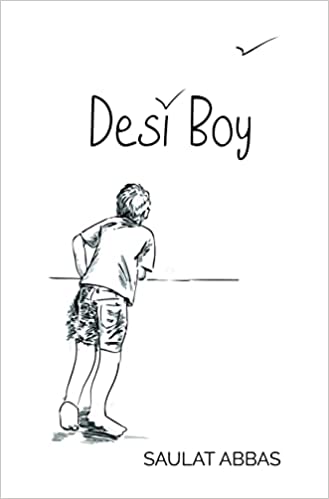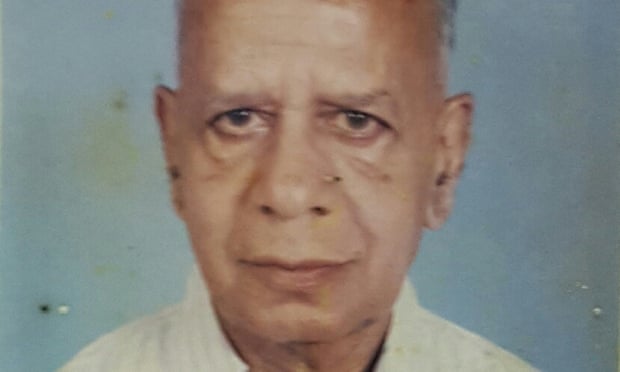Bulandshahr, UTTAR PRADESH / SAUDI ARABIA :
Abbas said he wrote the memoir to enable his children to know their father better.

In a letter to his friend Thomas Poole, Coleridge wrote that any life, however insignificant, would if truthfully told, be of interest. There are two important points in Coleridge’s observation. One, that it is not important whether the subject of a memoir, biography or autobiography has lived a very eventful life and achieved great success, as any life can be a good enough subject for a book. Two, truthfulness in reporting events of life is an essential feature of a book chronicling a life. And because a memoir lies somewhere between history and literature, the element of selection, omission, foregrounding, and downplaying of events of life can all be part of a memoir.
An ordinary life
Saulat Abbas’s memoir Desi Boy starts with his modest admission about his ordinariness. He states that his purpose in writing his memoir is to let his children know him if ever they decide to know about their father. “Given all the uncertainties of life, if god decides to take me away before my kids are mature enough to care about who their father is, this book, I believe, will satisfy their curiosity.” While Abbas, whose two marriages did not last long, lives in Saudi Arabia alone, alternating between the gulf countries and his motherland India, his teen-aged son lives in Taiwan with his mother, and his daughter in Malaysia with her mother.
Abbas’s truthfulness in reporting various events of his childhood, adolescence and youth, some even projecting him in a very bad light if seen from some established ethical principles, is the most important feature of his memoir. It certainly must have been an important decision for him to decide which incidents should or should not be included in his memoir. Thus indoctrinated to believe that the punishment for theft is chopping off hands, he almost chopped off the hand of Khajya, his young playmate, with an axe for stealing marbles, injuring him badly enough to leave a cut on his hand.
There is certainly interesting material in his ordinary life: a Muslim boy living in an eastern UP village in a patriarchal set-up struggling with his education; his family moving to western UP town of Bulandshahr where his anglophile father taught English in a postgraduate college; his student days at Aligarh Muslim University; his dreams and his aimlessness finally taking him to Saudi Arabia and Europe where he feels that he has made it. More than the external events, it is his intellectual and spiritual development and his struggle with some ethical principles that make the book eminently readable.
Undoubtedly the most authentic portion of the book is his account of his early childhood in his mother’s village where he was exposed to village superstitions, rural-agricultural practices, Tom Sawyer-like antics of stealing hens and the rigidity of caste structure where, contrary to their religion, Muslim landowners maintained caste hierarchy very ruthlessly. The author narrates how he and his cousins caused a big scandal in his family when they attended a Dalit wedding to watch a nautanki. “As far as I can remember, perhaps, it was the first time that the Sayeds were going to attend a Dalit marriage ceremony, and all because of the fun of the nautanki.” The punishment for this transgression from the elders in the family was fierce: “we could not sit after the caning.”
The villagers believed in black magic, witchcraft and often consulted a mulla, rather than a doctor, when taken ill. Formal education in this set-up was a rarity, often available in a madrasa, and was the prerogative of landowners’ sons as the poor villagers were kept away from learning. “If they became literate, who would do the farming?,” Abbas wryly asks. Writing was done on a wooden board, a takhti, which needed the application of a film of fine clay called multani mitti. For the author the whole process of preparing his wooden board for writing and making reed pens with a sharp tip “was more interesting than writing or learning so we did it as slowly as possible,” till his teacher lost his temper.
Life in the village
Many characters in his account of village life stick in memory. The foul-mouthed, amoral, “ever-giggly-jiggly” Okida, who gives many “arse-spreading ideas” to the author, is also a woman full of practical wisdom. Harcharan, a farm worker in his sixties, not only narrates tales of his sexual exploits, he also gave the author lessons in little thefts like stealing milk right from “the cows’ udders.” The lower caste, good looking Sudhua, who was probably fathered by a zamindar for whom his mother worked, taught him lessons in farming and agriculture as also in the exploitative and unjust social order in his village.
“If any member of Sudhua’s community ever combed his hair or wore sandals or slippers, he would be castigated. In physical care and style they were not supposed to “emulate’ the zamindar.” Shammu Khan, the private tutor known for his strictness, also taught the author lessons in morality and power structure in the family. Granny Iqfa who came from Calcutta not only has many tales behind her but her writing of poems in Urdu and Persian when women hardly had any education, makes her even more interesting.
The break in his idyllic existence and a brief experience of uprootedness informs his description of his life in Bulandshahr, where his family moves. Up to his High School days, he describes, how his lack of interest in studies and attending school made him one of the slowest learners in his class. His teachers had unshaken belief in corporal punishment which he learnt the hard way and his classmates smelled of curry, putting him off from studies further. “In my mind, school had become synonymous with the Nazi concentration camps…teachers looked like demons.” The ruins of houses left behind by people who migrated to Pakistan after the partition became his hideouts where he would spend time with city urchins, learning bad language, playing marbles and smoking bidi. He also specialised in committing petty thefts with friends to finance his passionate love for Hindi films.
An important part of his growing-up years in the college premises where his father worked was his mingling with his Hindu neighbours. Religion was never an issue in his friendships, rather “we learned about one another’s faith, and learned stories that were at the foundation of our religious beliefs.”
One particular incident about hierarchical system of education stands out. As he became more serious about his career, he thought of exploring the possibility of getting admission in St Stephen’s College, New Delhi. However, so mesmerised and scared was he to see the dress, language and confidence of students and staff in the College, that he could not even gather courage to even talk to anyone in the College: “I returned to the bus station, got back home, and never told anyone how heroically the villager was defeated on his first trip to a real city.”
There are a plenty of interesting, funny, and humorous situations in the book which are enlivened by the author’s self-deprecating humour. Thus in watching Hindi films he and his friends felt aroused by Helen, Aruna Irani, or Jayshree, but “respected our heroines…and never cast a lascivious look at them. We thought our heroes had exclusive rights on those women.” He relates how his father’s application for a job in a university in Saudi Arabia and his own application for admission to a course were mixed up by the person handling them in Saudi Arabia because he had learnt to copy his father’s handwriting perfectly. When his father received a letter that he could not get admission to the said course he did not know “that his job prospects in Saudi Arabia were screwed up by his brilliant son.”
There appears a little bit of drama in the narrative when a boy from a lower-class family in his village who had left for Lucknow and later Bombay comes back to his village in style after making it big. It turns out that Rasheed, who made people believe that he was part of the author’s family, to gain respectability and social status, was an underworld don on the run, and the author’s house was the safest place to hide. Obviously the elders in his family had to do a lot of explaining to the police officers who followed Rasheed in the village.
Reproduction of village life, especially some rural Hindi slangs and swear words entailed problems of their translation in English. He uses expressions like “arse spreading remedy” to translate a familiar swear word in Hindi. The author’s wit makes the book very readable. The common practice in his village of keeping the heads of children shaved meant that “five or six little neo-Nazis of similar age, size, and shape often roamed the orchard. Abbas’s style of writing includes allusions to many literary works, often reflecting his study of English literature. Thus nights are dark “like Iago”, and a deserted house, called Chhaouni in the village, reminds him of the atmosphere in The Duchess of Malfi and The Fall of the House of Usher. His uses similes very liberally all through his texts, many of them are very original.
Memory has a very important role in a memoir. It can sometimes play tricks and at other times it can be put to selective uses. The author does not always mention dates or years in reporting many incidents of his life. An aware Indian reader can draw an inference about the time of the incidents but for others the author leaves a lot of work to do. Thus if the author saw Sholay 25 times, one can make out that he is talking about the year 1975. It would also have helped if he had used the names of schools he attended. His account of Aligarh Muslim University could have been longer. The elaborate rituals attending a death in the family and various forms of the expression of griefs are rites of passage for him. However, the description of Moharram, its significance in his formative years and description of many events in Islamic history take something away from the main narrative of the memoir.
All through the memoir the narrator uses a royal “we” to narrate events and experiences which, since it is a plural subject, sometimes feels awkward in the narrative, that is, “We brought a two-page long essay back to my father. He made millions of corrections and trimmed it well, and we memorised it by writing it many times to make sure we were not going to make a mistake on our exam.” In the same way the author uses a common Indianism “beef” to refer to buffalo meat, which in the present context is a very problematic expression. It should have been replaced either by buff or simply buffalo meat, the common Hindi expression for which is “bade ka ghosht.”
In all, Desi Boy is truly an authentic and interesting account of a life because it is truthfully rendered by Saulat Abbas.

Desi Boy, Saulat Abbas, StoryMirror.
source: http://www.scroll.in / Scroll.in / Home> Book Review / by Mohammad Asim Siddiqui / December 10th, 2022









